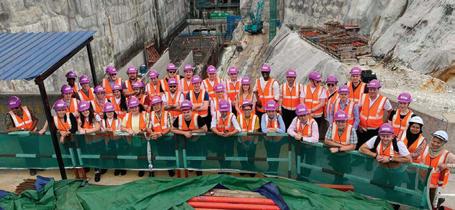
3 minute read
C annon Hall restoration
“Repointing was particularly sensitive as any lime mortar dropped on the soil could kill the rare pear tree collection” Michael Brearey FCIOB, Cardinal
Me and my project
Advertisement
Listed skills
MICHAEL BREAREY OF CARDINAL EXPLAINS THE SKILLS DEVELOPMENT OPPORTUNITIES A RECENT CONSERVATION PROJECT PRESENTED
The grounds and some buildings of Barnsley’s Cannon Hall have been restored to their former Georgian glory thanks to a Heritage Lottery Fund of £3m and Big Lottery Fund’s Parks for People programme.
The money has been used to restore original features, some of which have never been seen by the public. An intact ice house built in the 1700s will be revealed and a 0.8ha area of woodland behind the walled garden will be cleared and opened up. The gardener’s cottage will also be restored and a ‘midden’, an early example of an outside toilet, has also been revealed. For Cardinal, Cannon Hall not only allowed us to save and repurpose a number of listed buildings but to also continue with our initiative of upskilling the next generation and being an inclusive employer.
As part of the project we were able to employ three apprentices on site completing joinery works, one roofing apprentice and one general building apprentice, who was able to learn lime pointing, general brickwork repairs and how a listed building was built.
Top: Cottages at Cannon Hall after restoration
Above: Michael Brearey of Cardinal
Below right: Exterior and interior works under way
It is not often that an apprentice would be able to work on a wall constructed in 1760 which has a ‘spectacular collection of espaliered pear trees’ either adjacent or attached to it. The repointing works to this wall were particularly sensitive as any lime mortar dropped on the soil would have the potential to kill the rare pear tree collection.
The onsite project team was also made up of female operatives and a few ex-service personnel, ensuring that the site was fully inclusive.
Cardinal also gave work experience to a local student, who was able to get up close and hands on with the listed building, see the techniques and skills needed to work on one and gain real-life experience of ‘working’ on a building site. Our in-house HSEQ team visited site and the apprentice, Joe Vickers, also gained valuable site skills which has enabled him to complete his course.
Not all opportunities that Cardinal created as part of this project were on site: two further apprentices, based in our joinery workshop in Bradford, were responsible for creating timber products that were used in the build. Work on the roof revealed some amazing artefacts, as well as the original carpenters’ marks on the timber. To ensure that the building was safe there were various immediate repairs to the timberwork, thus saving historic timbers by installing new ones by the side of existing ones, or completing repairs rather than full replacement.

These immediate repairs were identified following the stripping-off of the roof, which highlighted some dangerous chimney stacks that needed to be supported and then fully rebuilt. Other discussions included ensuring the properties remained ‘bat friendly’, and flight paths uninterrupted, through bat tiles to the roof, changes in insulation and installation of bat boxes. Internal refinishing works included a full rewire, new heating system, new water installation, plastering, kitchens, bathrooms, fires and floor coverings. A further two buildings were structurally repaired using traditional methods coupled with modern stabilisation techniques and finished by reinstating more traditional roof coverings: changing the built-up felt roofing system back to stone slates.
The project’s challenges included bringing the building up to current regulations (where possible) and the relocation of bees.
I really enjoyed working with Cannon Hall, Barnsley Metropolitan Council and the Heritage Lottery Fund to deliver a project we can all be proud of. It is always brilliant to be involved in a project that preserves and restores existing buildings to their former glory either through conservation works to reinstate it for the next generation or through repurposing to give the building a new life. ● Michael Brearey FCIOB is construction director at Cardinal.











